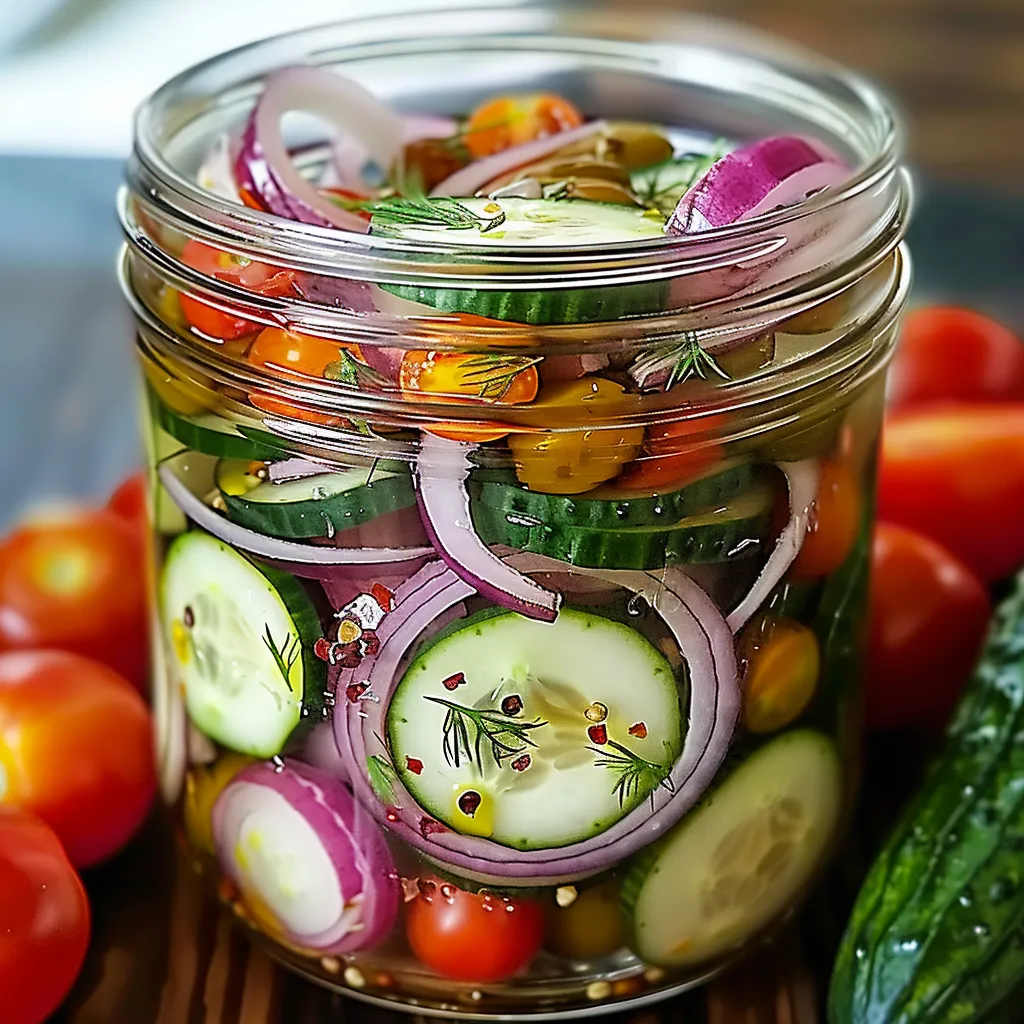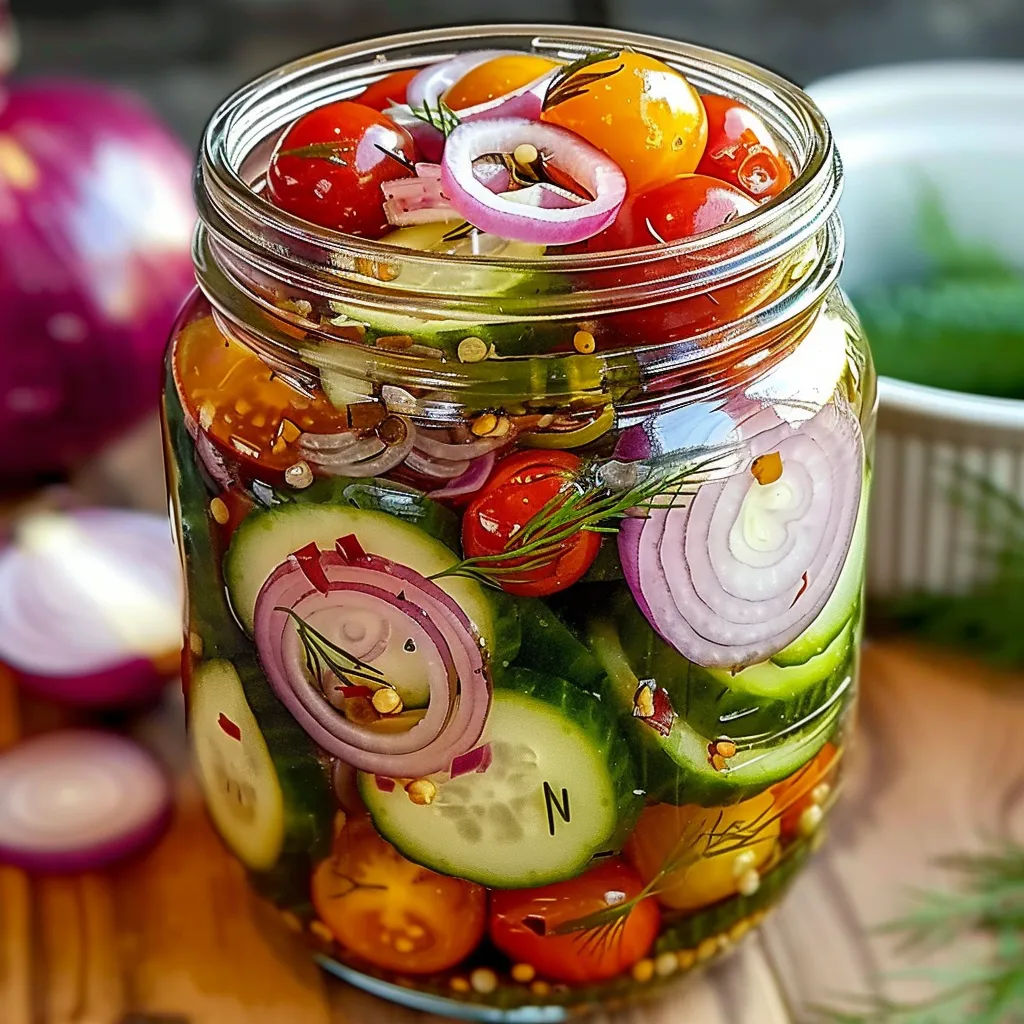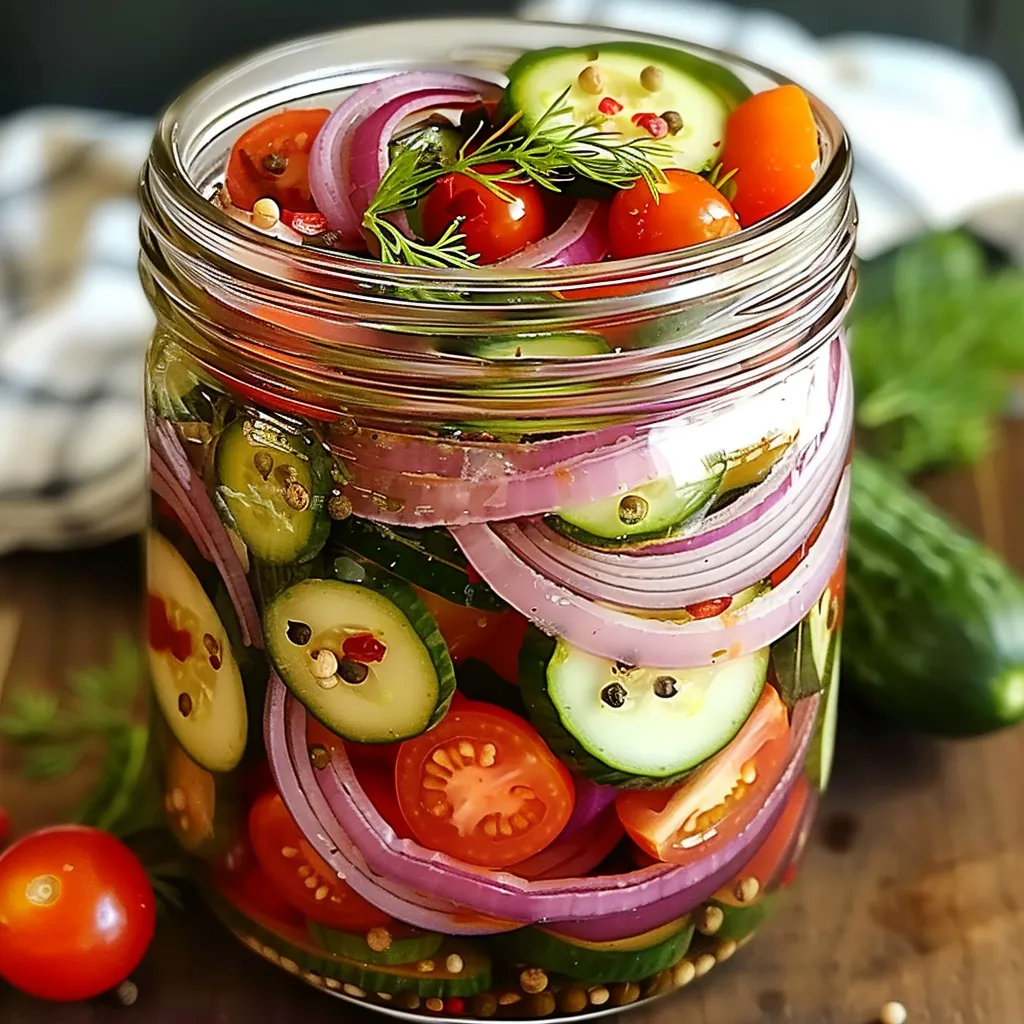 Pin it
Pin it
This colorful mix of pickled veggies adds zesty tang to any dish, turning regular produce into amazing flavor bombs with barely any work. The mix of juicy tomatoes, crunchy cucumbers, and sharp red onions creates a perfect combo that makes sandwiches, salads, and cheese plates so much better.
I stumbled on this idea during a crazy big garden harvest when I couldn't stand to throw away even one cherry tomato. These days it's my go-to trick for making boring weeknight meals feel special, particularly in cold months when I'm missing those bright summer tastes.
Ingredients
- Cherry tomatoes: Pick firm, whole ones for that perfect juicy pop after pickling
- Red onion: Gives a bold taste that gets milder in the brine
- Cucumber: Brings that must-have crunch, go for firm ones without wax
- White vinegar: Makes the tangy base needed for pickling
- Water: Cuts the vinegar down to get just the right tang
- Sugar: Fights the sourness and makes the veggie flavors shine
- Salt: Pulls out water and builds flavor
- Dried oregano: Adds that taste of Italy, get the good stuff
- Red pepper flakes: Give a slow-building warmth
- Fresh dill: Adds that key herby freshness, grab bright green bunches
Step-by-Step Instructions
 Pin it
Pin it
- Vegetable Preparation:
- Clean cherry tomatoes well and check for stems or mushy spots. Cut the red onion super thin so the brine can get all through it. Slice cucumber about 1/8 inch thick to keep it crunchy while soaking up flavor. Keep the skin on for a pretty color pop and extra texture.
- Brine Creation:
- Mix vinegar, water, sugar, salt, oregano, and red pepper flakes in a pot. Start heating slowly and stir all the time to make sure sugar and salt melt completely before it bubbles. This careful method stops crystals from forming and blends all the flavors right. Your brine should look clear and smell amazing when it's done.
- Hot Pour Technique:
- Put your veggies in a clean glass jar with some space between them so the brine can flow around. Pour the hot liquid over everything while it's still warm, which lightly cooks the outside and helps veggies soak up more flavor. Make sure all pieces are underwater to keep them from going bad.
- Dill Integration:
- Throw in fresh chopped dill after you've poured the brine, so its light flavor can soak in without cooking away. The warm brine will pull out the dill's natural oils, making it smell wonderful. Spread dill all through the jar so the flavor gets everywhere.
- Cooling and Aging:
- Close the jar and let it cool all the way on your counter before putting it in the fridge. This slow cooling helps veggies stay crisp while soaking up flavors. You can eat them after just two hours, but they taste way better and more complex after a full day.
Those bright red tomatoes always take me back to my grandma's garden. She showed me that pickling was the smartest kitchen trick ever. "You won't waste anything once you learn to pickle," she'd tell me while making similar jars that would fill her pantry all winter.
Storage Wisdom
These pickled veggies will stay good in your fridge for about two weeks, though they'll change a bit over time. Tomatoes slowly let out more juice while cucumbers might get a little softer after the first week. For the best results, store them in glass jars with tight lids instead of plastic, which can soak up flavors and mess up your pickles. The brine gets tastier as time goes on and can be saved to kick-start your next batch or used to make awesome homemade salad dressing.
Flavor Variations
Feel free to switch things up based on what's in season or what you like. Want an Asian twist? Swap out the oregano and dill for some sliced ginger and star anise. Love herbs? Throw in some thyme or rosemary with the dill. Need more crunch? Add thin slices of carrots or radishes to the mix. If you're big on garlic, drop 2 or 3 peeled cloves in the jar for extra flavor that gets stronger each day.
Serving Suggestions
These pickled veggies do way more than just sit on the side of your plate. Chop them up small for an instant topping for grilled meat or fish. Toss them in grain bowls to cut through heavier ingredients with their bright tang. They're awesome on meat and cheese boards, balancing out rich stuff with their zippy flavor. For an easy but fancy starter, spoon them over cream cheese and serve with crusty bread for spreading. Even the pickling juice can be drizzled on finished dishes to add a flavor kick.
 Pin it
Pin it
Quick pickling lets you grab summer's amazing flavors and enjoy them anytime. It's one of the most rewarding ways to save fresh veggies from going to waste!
Frequently Asked Questions
- → How long can I store pickled veggies?
If you keep them sealed and refrigerated, these pickled veggies stay good for about 2 weeks. The flavors deepen as time passes.
- → Can I tweak the spices?
Totally! Add your own spin with extras like garlic, thyme, or cracked peppercorns. Feel free to experiment.
- → Why boil the pickling liquid?
Heating the brine helps dissolve the sugar and salt thoroughly and gets the spices to release their flavors. It also ensures the liquid is clean.
- → Are other veggies okay to pickle?
Definitely! Toss in sliced carrots, radishes, or even bell peppers to mix things up and create a colorful batch.
- → What can I pair these with?
Enjoy these pickled delights on sandwiches, alongside salads, in tacos, or even as a charcuterie board garnish.
- → Do the jars need sterilizing?
For fridge pickles, clean jars are good enough, but if you’re making them to store longer, go ahead and sterilize the jars.
